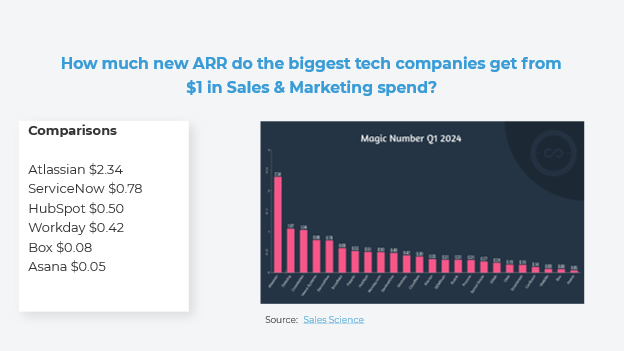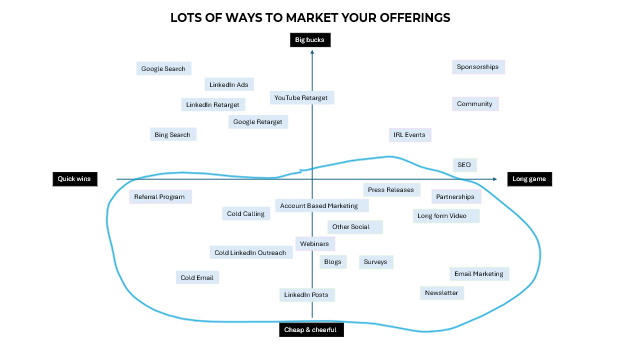
As a tech company, particularly one in the B2B SaaS space, competing with giants that have extensive sales and marketing budgets can feel daunting. You see companies like Atlassian and Asana making waves with billions in revenue and massive marketing budgets, but what if you’re not playing in that league? What if your budget doesn’t allow for large, multi-year paid advertising campaigns that may not even offer a quick return on investment?
For smaller tech companies or startups, the good news is you don’t need to operate on that scale to see growth. There are several effective, “cheap and cheerful” tactics that can deliver results without requiring a massive financial outlay. Here are some key strategies to consider when aiming for sustainable growth.
Pick a Market Focus
Instead of trying to compete on the same playing field as larger companies, narrow your focus. You don’t need to target millions of potential customers—focus on a niche market that you understand well. A rule of thumb: for every 10 new customers you want to add in a year, aim for a market of about 9,000–10,000 companies. With this kind of focus, you can build deeper connections and deliver more tailored solutions, which helps differentiate your brand.
Look for markets where you have experience and competitive differentiation. Evaluate factors like geography, openness to new technology, and whether you’re entering a greenfield space or replacing existing solutions. By being strategic with your focus, you increase your chances of landing deals without the need for expensive, large-scale campaigns.
Build a Strong Value Proposition
Once you’ve identified your market, the next step is to craft a clear value proposition. Too often, companies start spending on marketing without being clear about what they offer or how they’re different from competitors. Your value proposition should be succinct and focus on what sets you apart—whether it’s the product itself, the service, or the customer experience.
Without this foundation, your marketing efforts will struggle to resonate with potential customers. Ensure you’ve developed messaging that clearly communicates why someone should choose your company over others in your space.
Create Essential Marketing Assets
Before launching any marketing campaigns, make sure you’ve created all the essential assets that potential customers will need to engage with you. This includes:
- A professional website
- An active LinkedIn presence
- Buyer guides or downloadable content
- Case studies and customer testimonials
- Sales decks and product demos
These assets provide the information and credibility prospects need to self-educate before making contact. They’re also invaluable when driving potential customers through your sales funnel, especially if you’re looking to scale efficiently.
Set Realistic Goals and Track Metrics
Setting tangible, realistic goals is critical for any growth strategy. For example, if you want to add 10 new customers in a year and your win rate is 35%, you’ll need to generate about 30 opportunities. Breaking it down further, this translates to roughly three opportunities per month.
Focus on metrics that matter, like opportunity creation, rather than getting bogged down in less actionable goals like MQLs (marketing qualified leads). Opportunity creation is a straightforward way to track progress and stay aligned with your sales objectives.
Build a Short-Term Tactical Plan
When it comes to executing your marketing strategy, don’t try to plan too far ahead. A three-month tactical plan is ideal. This allows you to test different approaches, evaluate results, and make adjustments as needed. Your plan should include a combination of:
- Content creation
- Social media posts
- Email marketing campaigns
- Any other cost-effective tactics that align with your budget
By breaking the year into three-month increments, you can respond quickly to what’s working—and what’s not—without feeling locked into a long-term strategy that isn’t delivering.
Accountability Across Teams
Finally, hold the entire team accountable. Growth isn’t just a marketing problem—it’s a company-wide objective. Ensure that sales, marketing, and even customer success teams are aligned and focused on the same goal: driving opportunities and converting them into customers. By creating a culture of accountability, you can address issues quickly and ensure that every part of the company is pulling in the same direction.
In Summary
You don’t need to spend millions of dollars or have a massive brand presence to find success in the tech industry. By focusing on your niche, crafting a strong value proposition, and holding your team accountable to realistic goals, you can build a marketing and sales machine that works for your company’s size and budget.
Additional Resources
For more insights on driving growth with limited resources, check out:
- Our Coaching and Managed Services We offer a range of solutions designed to help tech companies build efficient growth strategies, optimize marketing processes, and fill skill gaps within your organization. Let TekStack support your journey to success!
- 8 effective sales tactics to drive B2B funnel growth (that won’t cost a dollar): a breakdown of actionable tactics you do each week to help you drive engagement, nurture prospects, and close more deals – without breaking the bank.

 Source: Sales Science
Source: Sales Science







